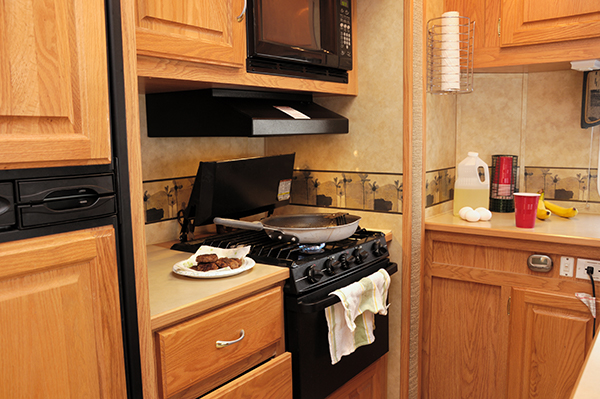Some newer RVs are equipped with a convection/microwave oven that uses electricity. However, the majority of motorhome owners still have the standard propane powered RV oven which many people treat like a toy or storage space. Sure, there are differences between an RV oven and an oven you’d find in a traditional house or apartment, but these things do actually work! If you keep certain discrepancies in mind and modify while baking, your dishes should turn out just as good as they would at home. Holiday cooking is possible too. Yes, you can cook a whole turkey or ham in that little RV oven if you want to.
Follow the 5 tips below to make sure everything you cook in your propane RV oven turns out just right.
1. RV Ovens Are Smaller
This is the most obvious difference of a motorhome oven compared with a standard oven in a house. Not a big deal at all! Just make sure to buy and use smaller pans and don’t buy the biggest turkey you see at the store. Cooking main dishes and side dishes at the same time may be a challenge, but that’s what a stove top and a campfire are for anyway, right? It’s easy enough to cook your ham or turkey in the oven and use the foil method to cook veggies on the fire or cook them over the burners.
2. Temperature May Be Inaccurate
 Home and apartment ovens can be slightly off the mark when it comes to temperature accuracy. RV ovens are often very inaccurate. Again, this is not a big deal. It certainly doesn’t render your appliance completely useless. The best way to treat this issue is to use a thermometer for several baking sessions to see how many degrees you need to calibrate the setting each time you want to use it. If your oven is consistently off by 12 degrees, you just need to set your oven 12 degrees higher each time you cook. And of course, always use an instant read thermometer on whatever you are cooking, especially meats. Problem solved!
Home and apartment ovens can be slightly off the mark when it comes to temperature accuracy. RV ovens are often very inaccurate. Again, this is not a big deal. It certainly doesn’t render your appliance completely useless. The best way to treat this issue is to use a thermometer for several baking sessions to see how many degrees you need to calibrate the setting each time you want to use it. If your oven is consistently off by 12 degrees, you just need to set your oven 12 degrees higher each time you cook. And of course, always use an instant read thermometer on whatever you are cooking, especially meats. Problem solved!
3. Give it Time
RV ovens can be frustratingly slow to get hot. This is one reason behind many complaints people have after trying to cook properly in their RV ovens. The problem isn’t that the oven doesn’t work. It’s just that it is slow to reach the desired temperature you need (up to a half-hour slow). That’s not the end of the world! Just give yourself a little extra time and use a thermometer to make sure your oven is hot enough before you pop in a big goose! Time how long your oven takes to pre-heat fully several times. That should give you a pretty good idea of how long you’ll always need to pre-heat. Just so you know, 20 to 30 minutes is pretty much the average.
4. Use This Trick for Even Heat
People often complain that their dishes get destroyed because the RV oven doesn’t heat evenly. And it’s true. RV ovens have this dilemma, but that doesn’t mean that you cannot use a simple hack to fix the problem. A propane gas oven uses a single flame with a metal plate above it that is intended to distribute the heat. The problem is that this plate usually gets really hot right above the flame and it cools down the farther you get away from the flame. Some seasoned RVers use a baking stone by placing it on the shelf. You’ll be amazed how this simple trick can really fix a huge problem.
5. Heat Both Sides Evenly
Even with a baking stone, sometimes one side of the oven gets hotter than the other. No big deal. Just set a timer so you can rotate the food when it’s half done cooking. It’s that easy: one extra step.
Once you get in the habit of making these minor adjustments to your usual cooking routine, your food will turn out just as good as it does in a regular oven. Even lavish holiday meals can be prepared in a propane RV oven. And don’t think that baking cakes and pies is out of the question. By tweaking the way your oven heats, you’ll get just the results you want with desserts too. And that’s the sweetest news!
The information in this article was obtained from various sources. This content is offered for educational purposes only and does not represent contractual agreements, nor is it intended to replace manuals or instructions provided by the manufacturer or the advice of a qualified professional. The definitions, terms and coverage in a given policy may be different than those suggested here and such policy will be governed by the language contained therein. No warranty or appropriateness for a specific purpose is expressed or implied.
